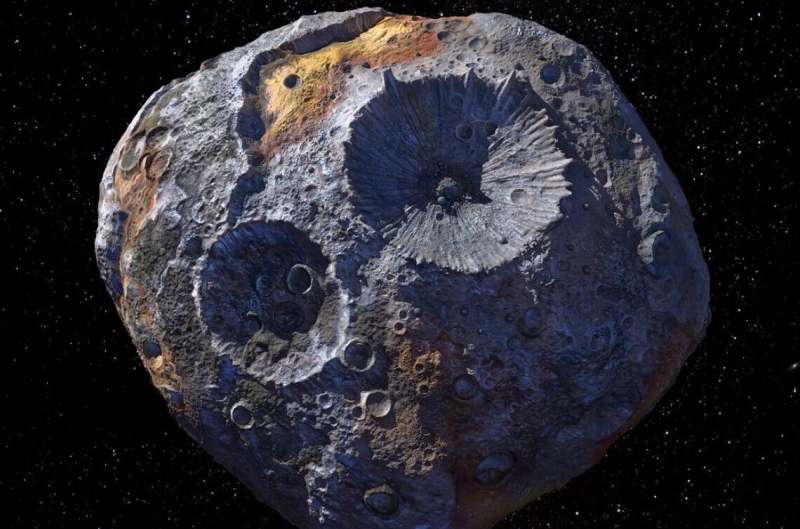The Psyche spacecraft is launched to the metallic asteroid of the same name to understand what a planet's core looks like
By Jim Bell, Professor of Space Exploration and Planetary Sciences, Arizona State University

French writer Jules Verne entertained 19th-century readers with the tantalizing idea that a journey to the center of the Earth was actually possible.
Since then, scholars have recognized that Verne's literary journey was merely science fiction. The extreme heat in the Earth's core - around 5,500 degrees Celsius - and the pressure, which is millions of times higher than on the surface, prevent people from going down very deep.
However, there are a few things we know about the Earth's core. For example, geophysicists have discovered that the core consists of a solid ball of iron and nickel that is 20% of the Earth's radius, surrounded by a shell of liquid iron and nickel that covers another 15% of the Earth's radius.
This data, and the rest of our knowledge of our Earth's core, has been learned indirectly - either by studying the Earth's magnetic field or by understanding the way earthquake waves travel from different layers beneath the Earth's surface.
But indirect detection has limitations. How can scientists find out more about what is going on deep in the earth?
Planetary scientists like myself believe that the best way to learn about the Earth's surface is outside it, in space. NASA's robotic mission to a metallic world is planned for launch in October 2023. The same mission, the spacecraft traveling there, and the destination it will explore - all bear the same name - 'Psyche'. For six years now I have been part of the NASA team of the 'Psyche' mission. This is a "first time" mission of launching a dedicated spacecraft to a metallic asteroid.
on the asteroid 'Psyche'
Asteroids are small worlds, with some the size of small cities and others as large as small countries. They are the building blocks left over from the violent early period of our solar system - the period of planetary creation.
Although most asteroids are rocky, icy, or a combination of both, about 20% of them are worlds made of metal, and are similar in composition to Earth's core. It is therefore tempting to imagine that these metallic asteroids are pieces of the cores of planets that once existed, torn apart in ancient cosmic collisions with each other. Perhaps, by studying these pieces, scientists could find out directly what a planetary core looks like.
Psyche is the largest known metallic asteroid. It was discovered in 1852. Its width is about 170 km, its spherical shape is distorted reminiscent of a pincushion, and its orbit is between Mars and Jupiter in the main asteroid belt. Astronomy enthusiasts can see 'Psyche' in an amateur telescope, but it appears only as a point of light.
On NASA's 'Psyche' mission
In early 2017, NASA approved the billion dollar mission to 'Psyche'. To carry out its mission, the unmanned spacecraft does not need to land on the asteroid. Instead, it will repeatedly circle the asteroid in a systematic and methodical manner, starting at an altitude of 700 km and then descending to an altitude of 75 km from the surface, and possibly even lower.
Arriving in August 2026, the probe will spend 26 months mapping the asteroid's geology, topography and gravity, looking for evidence of a magnetic field, and comparing the asteroid's composition to what scientists know, or think they know, about Earth's core.
About the 'Psyche' probe
The body of the probe is about the same size and mass as a large SUV. Solar panels, about the width of a tennis court, provide power for cameras, spectrometers and other systems.
Space-X's heavy Falcon rocket will launch 'Psyche' from Earth. For the rest of the way, Psyche will rely on ion propulsion – the gentle pressure of ionized xenon gas emitted from a small hole), providing a continuous, reliable and economical way to propel probes into the solar system.
The journey, a slow spiral of 4 billion km that includes a gravity assist flight through Mars. Throughout the flight, the Psyche team at NASA's Jet Propulsion Laboratory in Pasadena, California, and here at Arizona State University in Tampa, will remain in constant contact with the probe. Our team will send and receive data using NASA's deep space network of giant radio dishes.
Even if we discover that 'Psyche' is not an ancient planetary core, we will add a significant amount of knowledge to the existing knowledge about the solar system and the way planets form. After all, 'Psyche' is still unlike any world humans have ever visited. We may not be able to travel to the center of the Earth yet, but robotic messengers to places like Psyche could help us unravel the mysteries hidden deep within the planets - including our own.
More of the topic in Hayadan:
